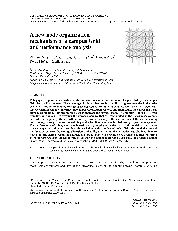摘要
This paper proposes a new node organization mechanism in the storage service provided by the Campus Grid Service Environment. The advantage of this architecture is its ability to aggregate nodes in the order of millions; the corresponding storage space aggregated can attain a petabyte level, which is a significant improvement in comparison with other campus Grids. Furthermore, this architecture is scalable and it can allow more nodes to join the storage pool to increase the storage space. The multilevel linked lists were first developed in order to organize the storage resources that are contributed by the nodes in the campus network. Subsequently, the algorithms were presented to analyze the mechanisms of the nodes: joining and leaving; storage resource scheduling and allocation; and unallocated storage space management. The performance of this system was investigated by employing a stochastic fluid model as the storage space changes with time as a result of the variation of the number of nodes. With this analytical model, the function between the storage allocation probability and the number of nodes was obtained. If more nodes join the campus Grid, the aggregated storage space will provide more available storage resources. If the storage resources allocation rate is less than the storage resources release rate, the available storage resources will increase and vice versa.
- 出版日期2006-12-15
- 单位西北工业大学
